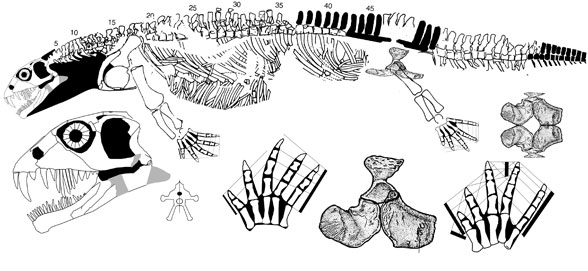
| Palaeos |  |
Archosauromorpha |
| Vertebrates | Helveticosauroidea |
| Page Back | Unit Home | Unit Dendrogram | Unit References | Taxon Index | Page Next |
| Unit Back | Vertebrates Home | Vertebrate Dendrograms | Vertebrate References | Glossary | Unit Next |
|
Abbreviated Dendrogram
DIAPSIDA |--LEPIDOSAUROMORPHA | `--ARCHOSAUROMORPHA |=="Protorosauridae" `--+?--CHORISTODERA |??-CHELONII (molecular phylogeny) |?--Helveticosauroidea | |--Helveticosaurus | `--SVT 203 (unnamed genus)`--+--Rhynchosauria `--+--Trilophosauria `--+--Prolacertiformes |--Drepanosauridae `--ARCHOSAURIA |
Contents
Overview |
 |
| Life restoration of the enigmatic diapsid Helveticosaurus zollingeri, Middle Triassic of European Tethys. Illustration copyright © Darren Naish (Flikr) |
During the Triassic Period, there was a tremendous evolutionary radiation among the diapsid reptiles. Among these, a surprising number of different lineages returned to the sea, where they quickly evolved into a number of specialised forms, superficially resembling the modern marine iguana in size and shape. Many were highly endemic. Among the strangest of these were the Helveticosaurs, whose bizarre appearance is featured in the illustrations on these pages. Whatever the helveticosaurs did for a living, they were reasonably succesful, as they continued for several millions of years of teh Early and Middle Triassic. Perhaps in the end they were out-competed by the turtle and walrus-like placodonts, which they closely but superficially resembled. Or perhaps it was just the changing environment of the Triassic world. In any case, by the start of the Jurassic, all these strange creatures had disappeared, the world was a less diverse place, and the seas were owned by ichthyosaurs, plesiosaurs, and marine crocodiles. In any case, these little known craetures are unique enough to deserve their own Unit on palaeos, at least until future research and phylogenetic anaylsis places them unambiguously among one or another of the better known reptilian groups of the Triassic. MAK110923
 |
| Reconstruction of skull and skeleton of Helveticosaurus zollingeri. The original animal was about 2 meters long. Drawing copyright © David Peters - Reptile Evolution - original url, reproduced with permission. |
Helveticosaurus was for some time classified as the most primitive member of the Placodontia (a clade of turtle-like Sauropterygia), in which it was given its own superfamily, the Helveticosauroidea. (Peyer 1955). Olivier Rieppel, an expert on Sauropterygia, rejects the Helveticosaurus is a placodont status of (Rieppel, 1989). Only the dorsal vertebrae of Helveticosaurus, which are very similar to those of placodonts, suggest that it is a member of the order; the genus lacks many of the autapomorphies characteristic of sauropterygians and thus evolved from a different ancestor, independently adapting a marine lifestyle. Its affinities with other diapsids remain largely unknown, as it differs greatly from any other known taxa, with no apparent close relatives. It shares some characteristics with archosauromorphs, and may be related to the clade if not a member of it. (Adapted from Wikipedia)
Rieppel argues on cladistic grounds that the Sauropterygia are lepidosauromorphs. But perhaps, if Sauropterygia fall on the archosauromorph side of the fence, then an archosauromorphian Helveticosaurus may represent a possible intermediate form. However, most who do support an archosauromorph status of Sauropterygia do so by grouping the Sauropterygia with the Ichthyopterygia (Ichthyosaurs and relatives) as the Euryaspida (Caldwell 1996; Merck 1997 ). This would make the Thalattosaurs, a group of diapsids of uncertain relationships but increasingly allied with ichthyosaurs, and in any case very unlike Helveticosaurus, basal Euryaspida and hence basal archosauromorphs. While David Peters presents a cladistic tree that nests Helveticosaurus in the thalattosauriforms, more derived than Askeptosaurus
Helveticosauroidea: Helveticosaurus zollingeri Peyer 1955.
Range: Early to Middle Triassic of Europe (north and central Laurasia)
Phylogeny: ???Archosauromorpha ::: * : Helveticosaurus + SVT 203
Comments: Originally considered basal placodonts. MAK101008
Range: Middle Triassic (Anisian/Ladinian boundary) of Monte san Giorgio, Switzerland (Tethys Sea)
Phylogeny: Helveticosauroidea : SVT 203 + *.
Reference: Peyer 1955.
Comments: From Wikipedia: "Helveticosaurus possessed many features that were adaptations to a marine lifestyle in the shallow-sea environment that existed in Europe at the time when much of the continent was part of the Tethys Ocean. The long, flexible tail is similar to what can be seen in other extinct marine reptiles such as thalattosaurs, and it probably propelled itself through the water by means of lateral undulation. However, Helveticosaurus also possessed a robust pectoral girdle and forelimbs that were well adapted for paddle like propulsion as a supplementary method of locomotion, as seen in secondarily aquatic tetrapods. This unique combination of undulation and paddling is highly unusual for an aquatic reptile."
Links: Wikipedia, Darren Naish - One of so many bizarre Triassic marine reptiles, Art Gallery - Silvio Renesto, David Peters - Reptile Evolution. MAK101008, 110923
Range: Early Triassic of Spitsbergen
Phylogeny: Helveticosauroidea : Helveticosaurus + *.
Comments: From Wikipedia: Pelvic material from SVT 203, may share similarities with the pelvic material known from Helveticosaurus. (Motani, 2000) However, this is only if the anterior element of the pelvic girdle in Helveticosaurus is interpreted as the pubis. The pubis of SVT 203 also shares similarities with placodonts, although the ischium differs in lacking constriction. SVT 203 was once referred to the ichthyosaur Grippia longirostris (Mazin 1981) but the pubis, femur, metatarsals, and phalanges suggest that it is not from an ichthyopterygian, therefore making it more probable that it belongs to a taxon related, and possibly ancestral, to Helveticosaurus, although more material is needed to give a definitive confirmation. The small size of material comprising SVT 203 in relation to Helveticosaurus, along with the compression seen on both ends of the femur, may indicate that it is a juvenile form of the species to which it belongs, but both temporal and geographical separation of SVT 203 with Helveticosaurus makes size comparison as a means of determining immaturity unnecessary, as it is possible that Helveticosaurus evolved from an ancestor that was smaller in overall size.
| Page Back | Unit Home | Page Top | Page Next |
page last modified MAK110923
